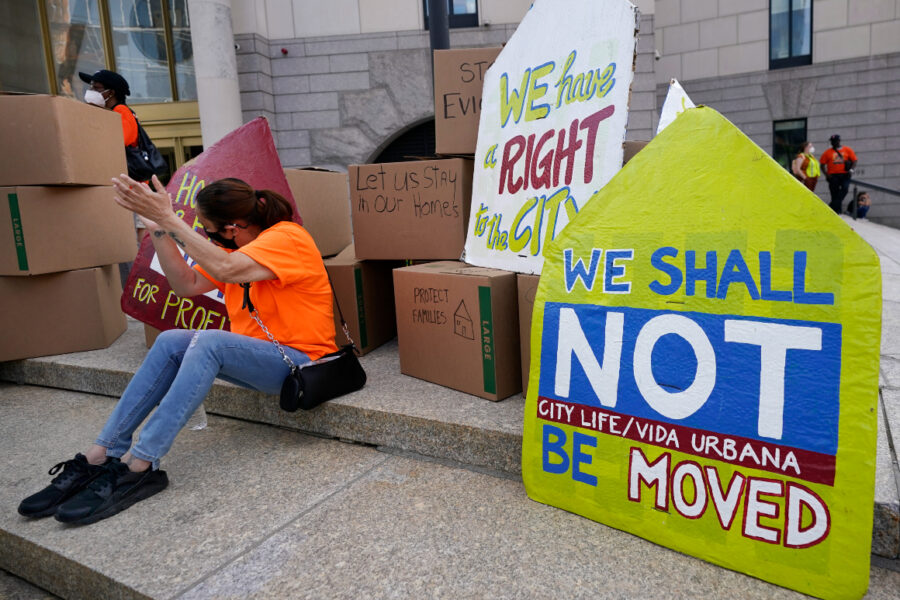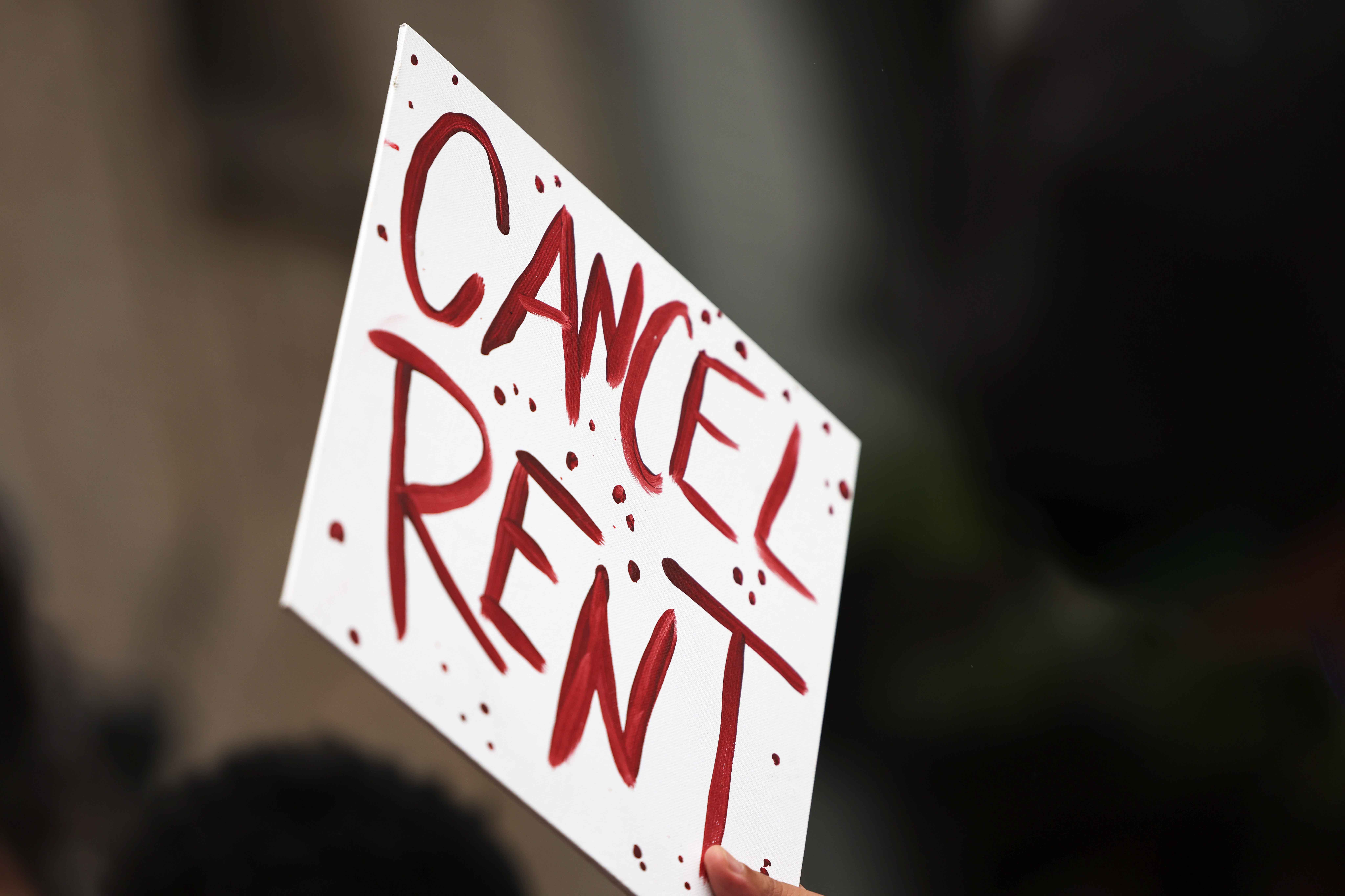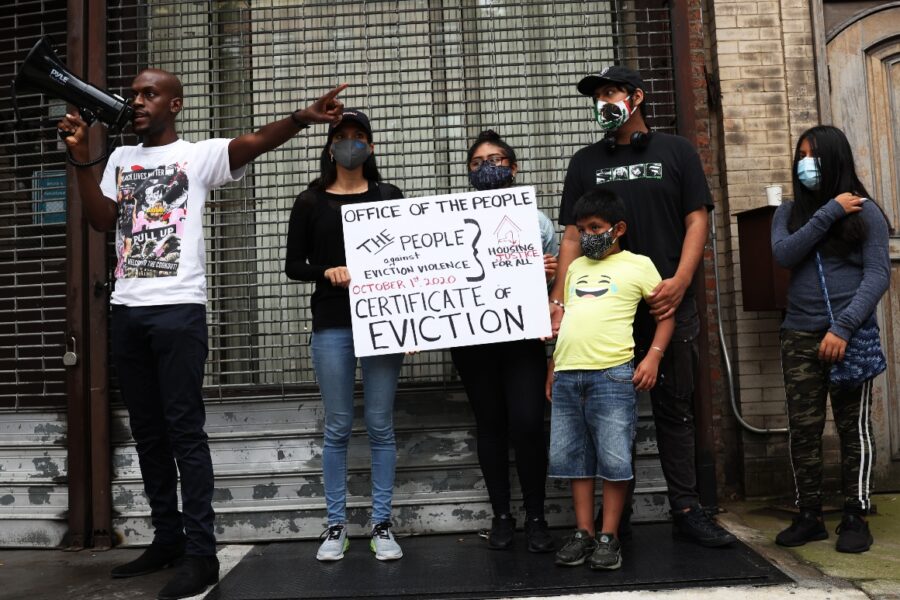‘Down the drain’: Millions face eviction after Biden lets protections expire

As the clock runs out on a nationwide eviction ban for what’s expected to be the final time, millions of tenants are staring at the prospect of losing their homes as they wait for emergency rental aid that the government has failed to deliver.
The federal eviction moratorium in place since September is set to expire Saturday, after the Biden administration refused to extend it and Democrats in Congress couldn’t muster the votes to intervene. Now lawmakers and activists fear an unprecedented surge in evictions in the coming months just as the highly transmissible Delta variant causes a spike in coronavirus cases.
The eviction wave is expected to hit population centers across the country. Housing advocates point to renters in Ohio, Texas and parts of the Southeast — where tenant protections are generally low, housing costs are high and economic problems from the pandemic linger — as particularly at risk. Even though it has its own ban in place through August, New York is also a concern, because it has been especially slow at distributing rental assistance funds to the hundreds of thousands of tenants in the state who are behind on their rent.
“We’ve been circling a drain,” said KC Tenants Director Tara Raghuveer, a housing organizer in Kansas City, Mo. “On Saturday, poor and working-class tenants go down the drain in some places.”
The last-minute gridlock between President Joe Biden and Democrats in Congress that resulted in the demise of the eviction ban this week threatens to impose new economic burdens on state and local governments. The officials will have to respond to mass evictions triggered by landlords — including many struggling financially themselves because of lost revenue — who are poised to kick out tenants who fell behind on their bills during the pandemic. The renter safety net is severely weakened, with fewer than a dozen state eviction bans in place and state and local governments having disbursed only a fraction of the $46.5 billion in rental assistance that Congress authorized over the past year.
President Joe Biden in a statement Friday called on state and local governments “to take all possible steps to immediately disburse these funds” given the ending of the moratorium.
“There can be no excuse for any state or locality not accelerating funds to landlords and tenants that have been hurt during this pandemic,” he said. “Every state and local government must get these funds out to ensure we prevent every eviction we can.”
Biden also suggested that they institute their own bans: “State and local governments should also be aware that there is no legal barrier to moratorium at the state and local level.”
Housing advocates are warning of awful images and hardships for many Americans who have suffered the most from Covid-19.
“My biggest concern is the dynamic of potentially tens of thousands of sheriff’s deputies and other law enforcement officials executing evictions around the country at the same time in the hottest month of the year,” said David Dworkin, president and CEO of the National Housing Conference, an affordable housing advocacy group.
About 7.4 million adult tenants reported they were behind on rent in the latest U.S. Census Bureau survey, which was taken during the last week of June and the first week of July. About 3.6 million tenant households said they were “somewhat likely” or “very likely” to face eviction over the next two months.
Others say the population of at-risk renters is much larger. The left-leaning Center on Budget and Policy Priorities estimates that 11.4 million tenants — 16 percent of adults living in rental housing — are not caught up on rent.

The lapse of the eviction ban, which was first imposed by the Centers for Disease Control and Prevention in September as a Covid-19 safety measure, comes after landlords warned that it cost them billions of dollars each month. Industry groups including the National Association of Realtors lobbied against extending the moratorium this week and made the case to lawmakers that it “unfairly shifts economic hardships to the backs of housing providers who have jeopardized their own financial futures to provide essential housing to renters across the country.”
The industry groups said the ban has been especially difficult for the mom-and-pop landlords who provide 40 percent of the country’s rental units. They “continue to pay mortgages, taxes, insurance and maintain the safety of their properties for tenants with less or, in many cases, no rental income,” the groups said in a late-night letter to lawmakers on Thursday.
The White House announced Thursday that it would not extend the moratorium because of the prospect of legal challenges, which have been spearheaded for months by landlords. The Biden administration cited a Supreme Court decision last month that kept the ban in place until July 31 but made clear that a majority of justices believed the CDC was exceeding its legal authority.
Biden urged Congress to intervene and pass a new prohibition, but at least a dozen House Democrats revolted as landlords and other housing industry groups warned of their own economic hardships.
The situation that will start unfolding Saturday will vary from state to state. In six states and 31 cities tracked by Princeton University’s Eviction Lab, landlords have filed for more than 451,000 evictions since March 15, 2020. Landlords typically file about 3.7 million eviction cases per year, and so filings are expected to swell in August.
In places such as Texas, which has allowed eviction proceedings to continue under the federal ban right up to the point of ejecting tenants from their homes, courts are likely to see a spike in eviction filings on Monday. Thirty-one percent of the 4.7 million adult tenants in Texas said they had “no” or “slight” confidence in their ability to make next month’s rent, according to the Census survey.
In Houston — the state’s largest city — nearly 40,000 eviction cases have been filed since March 2020, according to Princeton’s Eviction Lab. On average, Houston sees about 58,400 filings a year, suggesting a surge in filings is likely as the city gets back to normal.
Ohio has not enacted any special protection for tenants, and nearly 134,000 renters say they are very or somewhat likely to face eviction. Florida’s state ban lapsed in October, and more than 350,000 people are behind on rent.

And while New York has strong tenant protections in place through August, it’s also been among the slowest states to award relief money, distributing none of the first tranche of funds provided by Congress through June. There is no public data on New York’s disbursal of any second tranche funding.
State and local governments say it has been a struggle to put federal aid in the hands of tenants and landlords because they were forced to come up with relief programs from scratch.
The apparent aid bottleneck in New York has raised fears that it will face its own massive spike in evictions a month from now when a state ban expires. More than 860,000 tenants in the state say they are behind on rent.
Sunia Zaterman, executive director of the nonprofit Council of Large Public Housing Authorities, said there will be a “tsunami” of evictions.
“We’re standing on the beach watching the waves come in,” she said.
Melanie Wang, a national field organizer for Right to the City Alliance, is among the many housing advocates and even Democratic lawmakers who expressed frustration with the last-minute announcement from the White House that the ban would lapse and the situation was out of Biden’s hands.
“Yet again we are on the brink of a flood of evictions that tenants and housing advocates have been warning about for a year and a half now, and it’s been sort of a bungee-jumping experience,” Wang said. “So to have such a lukewarm response from the Biden administration at this point in time is really frustrating.”
Go To Source
Author: POLITICO

